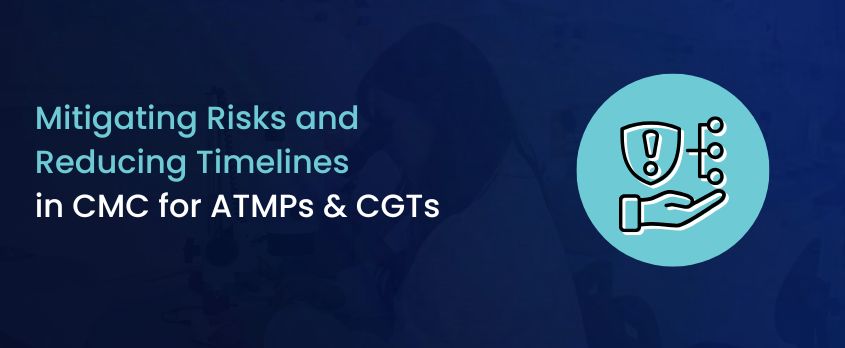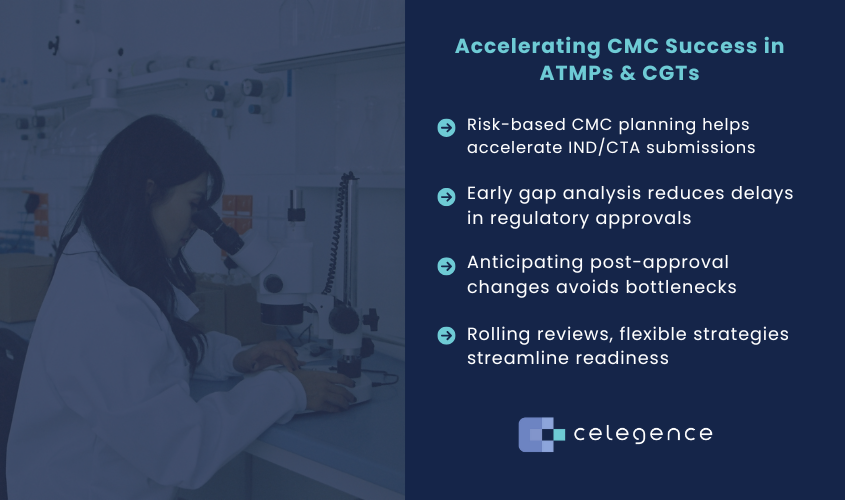
Mitigating Risks and Reducing Timelines in CMC for ATMPs & CGTs
While the potential of Advanced Therapy Medicinal Products (ATMPs) and Cell and Gene Therapies (CGTs) is groundbreaking, the regulatory and manufacturing hurdles can seem overwhelming. The key to success in this field lies not only in overcoming these challenges, but also in doing so efficiently. Reducing Chemistry, Manufacturing and Controls (CMC) timelines without compromising product quality is crucial for developers looking to accelerate the availability of these life-changing therapies. Let’s explore how manufacturers can reduce timelines and mitigate risks throughout the CMC process.
Reduced CMC Timelines
As pressure from funding boards and stakeholders increases, ATMP and CGT developers are often faced with the challenge of reducing time to Investigational New Drug (IND) and Clinical Trial Application (CTAs) submissions. However, rushing through CMC activities without thorough planning can lead to quality issues that ultimately extend timelines and increase costs.
To balance the need for speed with the assurance of product quality, applicants should conduct risk-based studies that identify critical areas where flexibility can be introduced without sacrificing quality and consistency.
Moreover, post-approval changes must be anticipated early in the development process. By considering post-approval logistics and CMC changes ahead of time, developers can avoid delays when the product is ready for commercial release. A well-defined post-approval change management protocol ensures that any adjustments made during development are accounted for, which can speed up the overall approval process.

Gap Analysis & Risk Assessment
A thorough Regulatory CMC gap analysis and risk assessment are crucial for identifying potential bottlenecks and mitigating risks. These assessments help developers pinpoint areas in the manufacturing process that may require additional attention or resources. For example, it’s essential to ensure that the manufacturing process itself is robust and meets regulatory standards, as any shortcomings can result in delays or rejection.
A detailed risk assessment should include an evaluation of the product’s control strategy, ensuring that it meets all regulatory requirements for quality and consistency. Additionally, developers must conduct a comprehensive characterization of the product, including stability data, to meet regulatory requirements. By identifying these gaps early, unexpected delays can be avoided and the development process kept on schedule.
Risk assessments should be dynamic and updated routinely to account for new information or changes in the development process. This proactive approach ensures that the CMC process stays aligned with regulatory expectations and reduces the chances of delays caused by unforeseen issues.
Optimizing CMC for Faster Approvals
The development of ATMPs and CGTs requires careful planning and execution to meet regulatory requirements while also accelerating timelines. By conducting risk assessments and gap analyses early, manufacturers can identify potential obstacles and mitigate them before they impact the overall development process.
Additionally, adopting a flexible approach to CMC activities, such as utilizing rolling BLA reviews and considering post-approval changes early, can help streamline timelines without compromising on quality. With the right strategies in place, regulatory CMC experts can help accelerate the path to market for these innovative therapies, ultimately benefiting patients in need of transformative treatments.
For foundational insights into global ATMP regulatory frameworks, see Part 1: ATMP Regulation in the EU and US – Global Convergence?. To understand CMC challenges and regulatory expectations, visit Part 2: CMC Challenges & Regulatory Strategy for ATMPs & CGTs.
For more information on how Celegence can help improve your regulatory compliance, reach out to us at info@celegence.com, contact us online or read more about Celegence’s services.


